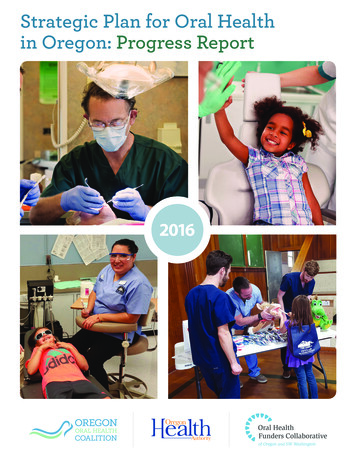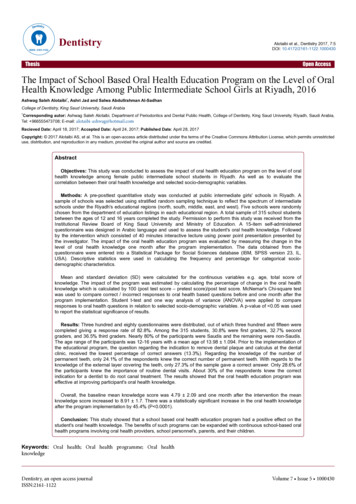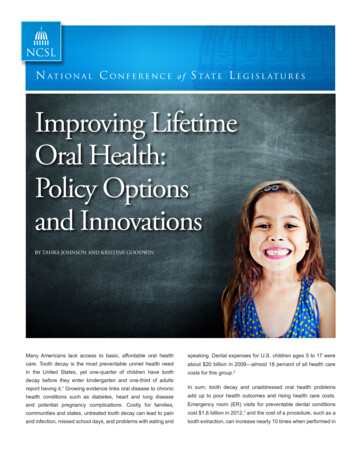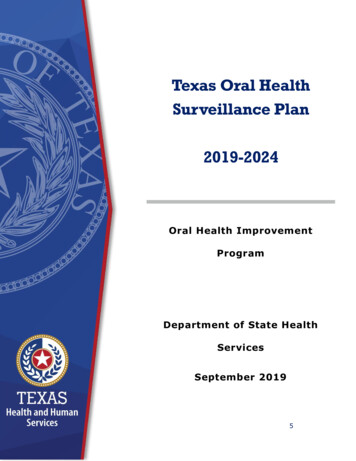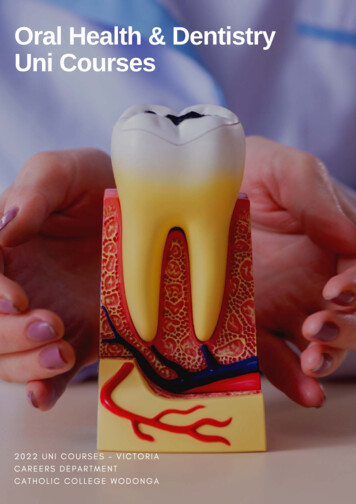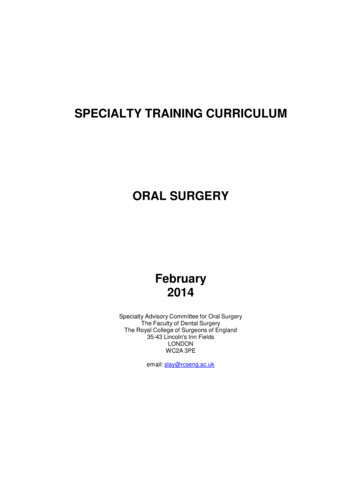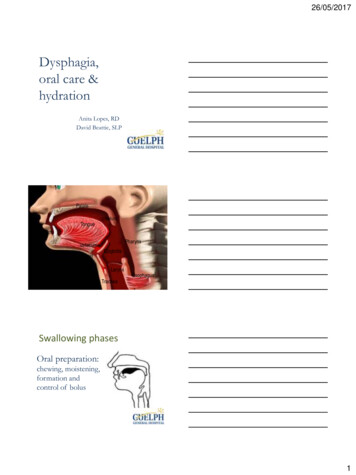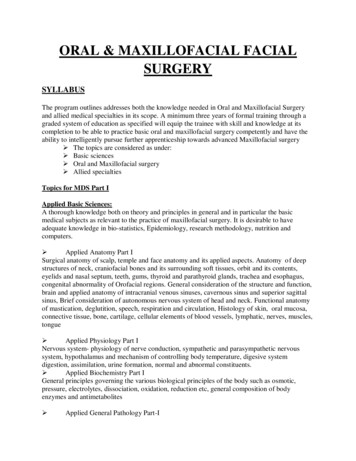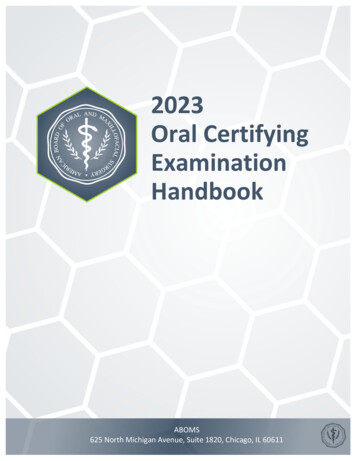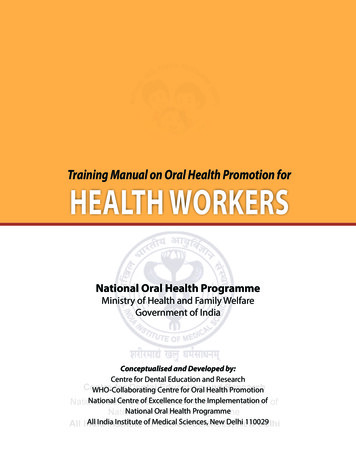
Transcription
Training Manual on Oral Health Promotion forHealth WorkersNational Oral Health ProgrammeMinistry of Health and Family WelfareGovernment of IndiaConceptualised and Developed by:Centre for Dental Education and ResearchWHO-Collaborating Centre for Oral Health PromotionNational Centre of Excellence for the Implementation ofNational Oral Health ProgrammeAll India Institute of Medical Sciences, New Delhi 110029
BackgroundPrimary Health Care is the bulwark of the public health care system in India.Many developed countries with health indicators that are several folds better,have turned focus on strengthening primary care and make it accountable.Frontline workers are the powerhouses of the Primary Health Care system. Thisworkforce is extremely diverse and is known by different eponyms in India,viz., Accredited Social Health Activist(ASHA), Auxiliary Nurse Midwife(ANM),Anganwadi Worker (AWW), Multipurpose Worker (MPW), Mid-Level Providers(MLP) and Nurses. The Health and Wellness Centres, slated to be the upgradedsubcenters in close proximity to the communities will be the hubs of significantactivity at the primary level.Among the multifarious duties performed by the frontline workers, healtheducation and promotion stand tall. Oral Health Promotion is suggested to beintegrated in this domain.Primary Health Care has the potential to reduce the morbidity that is the resultof oral diseases like decay, gum diseases, oral cancer and potential cancerousconditions of the mouth. This may help lower the cost to the system and theindividual, better than any other approach.This may help reduce the need forsecondary and tertiary care as well.Prioritisation of oral health promotion at the primary level is the key forimproved oral health outcomes. Prevention is the sinew of oral healthpromotion. Expanding the skillset of frontline workers for an inclusiveapproach that addresses oral health is the focus of this manual.It is expectedto back a robust training programme.Training Manual on Oral Health Promotion for Health Workers iii
The manual aims at enhancing the understanding of frontline workers on oral health,their abilities to communicate regarding this with families and promote behaviours thatare conducive to good oral health, following a life course approach starting from thepregnant women to neonates, children, adults, family, geriatric individuals and specialgroups,It would also help in management of a few dental emergencies like trauma toteeth.Universalising primary care which includes oral health care is the bigger goal, whichcould be realised soon with determined efforts that can reduce the rapidly escalatingdemand for treatment and care at higher levels of the health system. Working towardsthis may revolutionise the entire system of oral health care delivery in India.iv Training Manual on Oral Health Promotion for Health Workers
(NOHP)Training Manual on Oral Health Promotion for Health Workers v
Training Manual on Oral Health Promotion for Health Workers vii
viii Training Manual on Oral Health Promotion for Health Workers
Training Manual on Oral Health Promotion for Health Workers ix
Training Manual on Oral Health Promotion for Health Workers xi
xii Training Manual on Oral Health Promotion for Health Workers
Training Manual on Oral Health Promotion for Health Workers xiii
List of contributors1. Smt. Preeti Sudan, Secretary, Ministry of Health & Family Welfare2. Dr. B.D. Athani, DGHS, Directorate General of Health Services3. Sh. Sanjeeva Kumar, Additional Secretary (Health), Ministry of Health & FamilyWelfare4. Sh. Sunil Sharma, Joint Secretary, Ministry of Health & Family Welfare5. Sh. Ziley Singh Vical, Deputy Secretary, Ministry of Health & Family Welfare6. Dr. Mohd. Shaukat Usta, Advisor, NCD, Directorate General of Health Services7. Dr. A.K. Gadpayle, Additional DG, Directorate General of Health Services8. Dr. L. Swasticharan, Chief Medical Officer, Directorate General of Health Services9. Dr. Akriti Mehta, Consultant, NOHP, Ministry of Health & Family WelfareTraining Manual on Oral Health Promotion for Health Workers xv
List of technical experts1. Dr. O.P. Kharbanda, Chief, CDER, AIIMS, New Delhi2. Dr. Sanjeev Kumar Gupta, Professor, Community Medicine, AIIMS, New Delhi3. Dr. Poonam Khattar, Professor, NIHFW4. Dr. Rajani R. Ved, Executive Director, NHSRC5. Dr. Vijay Mathur, Professor, CDER, AIIMS, New Delhi6. Dr. Harsh Priya, Assistant Professor, CDER, AIIMS, New Delhi7. Dr. Vikrant Mohanty, Associate Professor, MAIDS, New Delhi8. Dr. Arpit Gupta, Assistant Professor, PGIMER, Chandigarh9. Dr. Anupama Ivaturi, Senior Resident, CDER, AIIMS, New Delhi10. Dr. Neha Dumka, Consultant, NHSRC11. Dr. Desmia Haldane, Ex-Senior Research Fellow, NOHP, CDER, AIIMS, New DelhiTraining Manual on Oral Health Promotion for Health Workers xvii
What’s inside?1. Your role as a frontline worker .12. Objectives .53. Healthy mouth .74. Common oral diseases. 11i. Tooth decay/cavities . 11ii. Gum diseases. 16iii. Irregular alignment of teeth/jaw. 18iv. Potentially cancerous conditions in the mouth and oral cancer . 22v. Trauma to the teeth and face . 24vi. Dental fluorosis. 265. Target groups . 27i. Expectant mothers. 27ii. Infants. 30iii. Geriatric age groups. 32iv. Medically compromised and hospitalised individuals . 336. Prevention is better than cure . 35i. At home care. 35ii. Professional measures . 447. Points to remember. 498. Checklist. 519. Frequently asked questions. 5310. Common myths and facts about dental health. 5711. Activities. 6312. Glossary. 85Training Manual on Oral Health Promotion for Health Workers xix
Your Role as aFrontline WorkerAvoiding sweet and sticky foodsBrushing twice a dayOral health is an integral part of overallhealth. Oral Health problems liketooth ache associated with decay,gum diseases, irregular alignment of teeth,and mouth cancer are prevalent in India,some to an extent of nearly half of thepopulation. Identifying and treating such awide range of diseases incurs an economicburden on the country.Therefore, it is important that a strategy bedeveloped to nip these problems in the budand put forth prevention as a single pointagenda to tackle them.Formal training in dental schools is adefinite requirement for treatment of dentaldiseases. Prevention on the other hand caninvolve health workers, school teachers andpersonnel in other sectors who have accessto interactions with large groups of people.Regularly consulting a dentistyour role as a frontline worker 1
Dental Health Education at the grass-root level can help curtail oral health problemsto a large extent. Health Care Workers and School Teachers in rural and urbanareas can be the best health educators to convey the message on good oral healthpractices and preventive measures.2 Training Manual on Oral Health Promotion for Health Workers
You have the edgenAs the torch bearers of community health in your region / ward / locality you allare at a definite advantage to carry forward the fact that dental diseases have abearing on overall healthnYou are more approachable and your reach is widernYour appropriate referrals to the local dentists will boost up awareness furthernInformation dissemination among masses related to good oral health is a moraldutyyour role as a frontline worker 3
ObjectivesAfter reading this manual, you will know how to:nnnnnPromote oral healthIdentify and prevent common oral diseasesGive first-aid in dental emergencyCare for special groupsAppropriately referobjectives 5
Healthy Mouth6 Training Manual on Oral Health Promotion for Health Workers
Healthy MouthThe mouth leads to the oral cavity. The oral cavity has teeth, gums and the followingpartsTongueThe tongue is a freely movable muscular organ present in the oral cavity. It aidsin taste, speech, chewing and swallowing. The upper surface of the tongue hasprojections called papillae which bear taste buds.PalateThe roof of the mouth is formed by the palate. The bony part of the palate is calledhard palate and behind the hard palate is the soft palate.CheekThe mouth/oral cavity is bound by the upper and the lower lip and the inner side isthe cheek. The oral cavity is lined by a specialized layer of the skin called mucosa.TeethnTeeth are vital structures of the body with a definite blood and nerve supplynHumans have two sets of teethn-Milk teeth/ Baby teeth/ Primary teeth-Adult teeth/ Permanent teethThe first to appear are Milk Teeth and are helpful to the child not only for chewingbut also in providing guidance to the developing jaw and permanent teeth.Healthy Mouth 7
There are four different types of teeth in human beings.1. Incisors: They are the front teeth, four in the upper arch and four in the lowerarch. They are shaped to bite and cut food into small pieces2. Canines: They are conical teeth at the corner of the mouth. Their function is totear or shred food.3. Premolars: These are two on each side of both the jaws just behind thecanines. The function of these teeth is to hold and crush the food. Premolars arepresent only in adults.4. Molars: They are three in number on each side of the jaws and have biggerchewing surfaces for cutting food into smaller particles.There are two incisors, one canine, two pre-molars and three molars making eightteeth in each half of the jaw and a total of thirty-two teeth in permanent dentitionParts of TeethnThe pearly white visible part of the tooth is the crown and the longer portionanchored inside the gum and the bone is the root.nThe outermost hardest white cover is known as the enamel. The inner relativelyless hard part is the dentin. It surrounds the pulp containing blood vessels andnerves of the tooth.Parts of a tooth8 Training Manual on Oral Health Promotion for Health Workers
Sequence of Tooth EruptionHealthy Mouth 9
Healthy GumsHealthy teeth and gumsin a childHealthy teeth and gums inan adult mouth All the teeth are embedded in the jawbone which is covered from outside by aspecialised layer of the skin, called the Gums / Gingiva. Healthy gums are generally pink in colour. They are firmly attached to the boneunderneath.You RememberDo You Remember1. What are the different parts of the tooth?2. List the four types of teeth3. How many sets of teeth do we have?4. How many permanent teeth do we have?5. What is gingiva?6. When does the first tooth come out in the mouth of a child?10 Training Manual on Oral Health Promotion for Health Workers
COMMON ORALDISEASESThe common oral diseases are: Tooth decay / Dental cariesGum diseases/ GingivitisIrregular teeth / MalocclusionOral cancer and its warning signsThe signs and symptoms of these, with easy ways of identification and preventionare detailed in the next few pages.Tooth decay / Dental cariesTooth decay appears as a brown or black discolouration on the tooth, which onprogression leads to formation of cavity. Tooth decay affects baby and adult teeth .Signs: Brownish/black discoloration Hole / cavity on the tooth or in between two teeth Broken tooth Tooth pain on touch If left unnoticed, complications like– Pus discharge– SwellingBlackdiscolorationBlack discolorationCavityHole/cavity in betweentwo teethHole/cavity in betweentwo milk teethCOMMON ORAL DISEASES 11
Symptoms of dental decay and abscess: Pain on chewing on that particular side Food lodgement on or in between the teeth Sensitivity on consuming hot/cold food Swelling, referred pain, severe discomfort and associatedfever on leaving the decay untreated for a long timeWhat causes dental decay?BacteriaPus discharge and swelling dueto decayTooth surfaceBacteria are very small organisms not visible to naked eye.Normally present in the oral cavity of every individual. Thesebacteria live in a slimy, transparent layer on tooth as DentalPlaque.Plaque is normally not visible on tooth surface.The grooves, pits and fissures naturally present onchewing surfaces of teeth are difficult to clean. Bacteriatend to accumulate here leading to tooth decay.Decay may also occur if food is left between two teethfor a long time.Time lapseIf food is left in the mouth for a long time, bacteriatend to accumulate, release acids and thus lead todecay.Sweet and sticky foodConsumption of sweet and sticky food like toffees,chocolates, cakes, biscuits frequently and in-betweenmeals leads to decay.Bacteria attacking tooth12 Training Manual on Oral Health Promotion for Health Workers
The Causes of Dental DecayProcess of Dental DecayCOMMON ORAL DISEASES 13
Progression of dental decayBlack spot/cavityin enamelDeepening of cavityto involve dentinDeepening of cavityto involve pulpVisible part oftooth inmouthRootsof teethanchored inboneNursing Bottle Decay/Early Childhood Decay It is seen in babies on bottle feed.Involves rapid destruction of multiple teeth.Most commonly affects upper front and lower back teeth.Lower front teeth are spared as they are covered by the tongue during feeding.Avoid letting baby sleepwith sweet nipple or bottlein the mouthNursing Bottle Decay14 Training Manual on Oral Health Promotion for Health Workers
Signs Brownish black discoloration Broken upper front teeth Continuous presence of sweetened milk / sticky / sweet food in the mouthSymptoms: Early loss of milk teeth Difficulty in eating Pain and dental abscess Unpleasant appearanceEffects: Early loss of milk teeth Delayed eruption of permanent teeth Difficulty in eating Unpleasant appearance MalnourishmentYour roleDo Identify the black spot/ discoloration/pain/ pus discharge If painful gently apply little cloveoil inside the tooth cavity withouttouching the gum or oral mucosa Prescribe one dose Paracetamoltablet Refer to the nearest dentistAdvise Rinsing mouth thoroughly withwater after every meal / snack For small babies give water as a lastfeed Brush teeth twice a day Avoid self medication of pain killers Avoid placing camphor/ tobacco /petroleum products/ pain balm/ saltat the site of pain Avoid application of heat / any painrelief cream in the area of pain eitherexternally or in the mouth Avoid picking teeth using anyobjectsCOMMON ORAL DISEASES 15
Gum DiseasesEarly stage of gum disease is called GingivitisSigns and Symptoms Foul odour from the mouth/bad breath Deposits on teeth Bleeding gums Swollen gumsProgressionIf Gingivitis is not treated, it may progress to a severe stage of the disease known asPeriodontitis. It is also called Pyorrhea.Impact of gum diseases on overall health: Advanced stages of pyorrhea can effect sugar control. In Diabetes, Periodontitis is a known complication.GingivitisBleeding gumsTartarPeriodontitisSwollen gums16 Training Manual on Oral Health Promotion for Health WorkersMigration of teeth
Signs and Symptoms Dull constant ache Bleeding from gums Loose teeth Foul odour/bad breath Gaps between teethBad breathCauses The gum diseases are caused by poor oral hygiene and plaque accumulation. The bacteria present in plaque form toxic substances that may cause inflammationof gums. If plaque is not removed regularly, it may harden to form calculus (tartar). The rough surface of tartar attracts further deposition of plaque and bacteria. This leads to progression of the disease and destruction of underlying boneYour roleDo Patient having diabetes, heartdiseases or on any regularmedication will require extraprecaution for dental treatment. Refer to dentist for expert dentalopinion. Pregnant mothers also need referralto dentist for dental check up.Advise Rinse mouth with water Tooth brushing Avoid picking teeth using anyobjectsCOMMON ORAL DISEASES 17
Irregular Alignment of Teeth / Jaws (Malocclusion)Any deviation from the normal alignment of teeth and / or upper / lower jaw. It maycompromise the appearance or the functions like speech and chewing.Signs Abnormally forward or backward teeth / jaw Gaps between the teeth Uneven crowded teeth Cross bite / reverse bite Asymmetry of faceForwardly placed teeth Pain in the joint between upper and lower jawSymptoms Difficulty in pursing lips Unpleasant appearance Difficulty in keeping teeth clean because they areIrregular alignment of teethcrookedCauses of malocclusion Early loss of milk teeth due to dental decay. Oral habits causing abnormal pressure on teethand surrounding structures such as thumband finger sucking, tongue thrusting, mouthbreathing, nail bitingEffects of MalocclusionCan severely affect the child’s Appearance Low on confidence and self-esteem Increased chances of dental decay and gumproblems Teeth that are abnormally forward may get injuredeasilyThumb sucking habitNail biting habit18 Training Manual on Oral Health Promotion for Health Workers
Cleft Lip/ PalateA split in the lip or the roof of the mouth seen at birth is called cleft.Signs and Symptoms Split lip/ palate or both Feeding, swallowing and speech difficulty Unpleasant appearance of the faceA split in the lipChild with Cleft Lip & PalateYour roleDoAdvise Identify habits Advise parents on stopping bad oral Refer to the nearest dentisthabits In case of cleft, follow Rashtriya Educate on feeding practices forBal Swasthya Karyakaram (RBSK)cleft childrenProtocol and refer to the DistrictEarly Intervention Centre (DEIC)under RBSK.COMMON ORAL DISEASES 19
Missing tooth / teethLoss of tooth or teeth The jaws without teeth are called “edentulous” Partially edentulous- when a few teeth are missing from either upper or lower jaw Completely edentulous - when allteeth are missingSigns and symptoms Missing teeth Inability to chew Difficulty in speech in case ofmissing front teeth Unpleasant appearance andcompromised smileMouth with no teethCauses Neglected, long standing decaywhich progresses to broken toothand complete loss of tooth Untreated pyorrhea, mobile teethleading to complete loss of tooth /teeth Trauma/ road traffic accidentsMouth with missing front toothwhich lead to loss of front teeth Systemic diseases and bone disorders which weaken support and lead to toothlossYour roleDoIdentify and refer to the nearest dentist for replacement of missing teeth20 Training Manual on Oral Health Promotion for Health Workers
Fungal Infection of the MouthMost common fungal infection of the mouth is Candidiasis, also called oral thrushSigns Whitish curd like patch which can be removed by rubbingSymptoms Burning sensation/ pain Cracked corners of mouth Foul odour Difficulty in swallowing / chewing Altered tasteCauses Immune compromiseCandidiasis Ill fitting denture Continuous use of antibiotics/ steroids Use of inhalers by asthmatics Neglect of oral hygiene Chemotherapy/ radiotherapy Dry mouthYour roleDoAdvise Identify Advise on discontinuing the use of ill Refer to the nearest dentistfitting / faulty dentures Ask for history of systemic health Correction of denturesproblems Rinsing with salt water Tooth brushing Advise on consumption of morewater and keeping mouth wetCOMMON ORAL DISEASES 21
Oral Cancer and its early detectionOral cancer is one among the six most common cancers in the world.In India, it is one of the three most common cancers.Risks Betel nut/Smokeless/Smoking tobacco consumption in any form Long standing irritation due to sharp teeth and faulty dentures Frequent and long standing alcohol consumptionWarning signs Long standing non-healing ulcer for more than 2 weeks A white or red raised patch in the mouth Restriction in mouth opening. A lump or growth in the mouth A lump in the neckSymptoms: Difficulty in chewing/ swallowing Reduced mouth opening Burning sensation in the mouth, change in voiceWhite patch in mouthLong standing non-healing ulcer22 Training Manual on Oral Health Promotion for Health Workers
Your roleDo Identify the risk factors Examine the mouth Follow the PopulationBased Screening Protocolfor Oral Cancer and referto nearest dentistAdvise Advise Brief Intervention for quittingtobacco/ betel or such products Delay the consumption of tobaccoDistract/ divert the mind fromtobacco towards any other activitylike music/reading/conversing withfriendsDrink water frequently and keep themouth wet to reduce the craving fortobaccoDeep breathe/ Do exercise to controlthe cravingsCOMMON ORAL DISEASES 23
Trauma to the teeth and faceTeeth and face may get injured easily. Playing/cycling/running Physical violence Sports injuries FallsIt may occur at home/schools/ playgrounds oranywhere else.Signs: Broken tooth/ knocked out tooth Bleeding Wounded and swollen lips Lost front tooth Back teeth not meetingSymptoms: Pain Bleeding Numbness Progressive reduction in mouth opening after traumaBroken upper front teethKnocked out/avulsed tooth24 Training Manual on Oral Health Promotion for Health Workers
Your roleDo Arrest bleeding withpressure/ cold pack Save the knocked outtooth/ broken toothfragment and place itin milk/ water/ tendercoconut water Refer to the nearestdentist within onehour If the injury involvesface/ head, refer to thenearest health facilityimmediately.Dont’s:Advise: Do not rub /scrub the Promotingsafetoothenvironmentsfor Do not wrap the toothpreventing traumain a soiled cloth Do not let the toothdry Do not throw thetooth or the brokenfragmentCOMMON ORAL DISEASES 25
Dental FluorosisPresence of brownish yellow spots or roughened surface on the teeth due to highamount of fluoride in drinking water supply is called dental fluorosis.In severe form, fluoride may get deposited in the bones. This is known as skeletalfluorosis.Signs: Chalky white teeth Brownish yellow stains PittingYour roleDoIdentify the condition and refer to nearest dentistDo You Remember1. What is a cavity?2. What is dental plaque?3. What is nursing bottle decay?4. What is periodontitis?5. What will happen if gum diseases are not treated in time?6. What are the ill effects of crooked teeth?7. What is cleft lip and cleft palate?8. Who is at the risk of developing oral cancer?9. Enumerate the signs that may be seen in a person with oral cancer.10. When should a patient with dental trauma report to a dentist?26 Training Manual on Oral Health Promotion for Health Workers
Target GroupsSpecial attention to be given to: Expectant mothers Infants and children Old age Individuals Medically Compromised/Hospitalised individualsExpectant mothersWhy? Hormonal changes in the body and its effect on thegums leading to inflammation, swelling and bleedingfrom gums. If gum disease is neglected, it may also affect the baby,leading to low birth weight of the new born and preterm labour. Tobacco and alcohol abuse during pregnancy leads tobirth defects like cleft lip and palate.Target Groups 27
Your roleDoAdvise Instruct the pregnant women about Tooth brushing with soft brush andthe possible oral health problemspea size amount of tooth pasteduring pregnancy.twice daily. Identify the oral health problem and Rinsing mouth thoroughly withrefer to the nearest dentist.water after every meal Rinsing mouth with warm salt waterin case of bleeding gums. Consulting a dentist in case of toothache / any other oral problem Avoid self medicating for tooth ache/ swelling during pregnancy Visiting a dentist for dentaltreatment is safe during the first andthe third trimester of pregnancy.28 Training Manual on Oral Health Promotion for Health Workers
Quick reference for Oral Health during pregnancyMotherhood–a reason to SmileLet the Dentist know about your pregnancy. Your treatment can beplanned accordinglyQuitting brushing will lead to further accumulation of plaque andaggravate disease. Consult your Dentist and seek professional adviceDon’t self medicate for any tooth related problems. Consult yourDentist at the earliest .Consultation visits for cleaning, tooth removal are safe to beperformed during the second trimester.Poor oral hygiene leading to severe pyorrhea can effect pregnancyoutcomes.Baby’s gums need to be cleaned using a moist, clean cloth.Start brushing the child’s tooth with a baby toothbrush as soon as thefirst tooth erupts in the mouthAfter the first birthday of the child, take him/her for check up to theDentist.remember that Oral health is Ovrall health.Target Groups 29
Infants and childrenWhy? After birth baby’s mouth faces new environment Continuous presence of milk /sweetened milk or food in the mouth Attempt to introduce oral hygiene early on in life Irritability and problems when teeth begin to eruptEducate about gum pad cleaningGum pads are seen in the mouth of infants/ babiesSteps for gum pad cleaningThe mother must be instructed as follows Wash hands with soap and water Prepare a clean, moist, soft cotton cloth Wrap the cloth around the forefinger anddamp it in drinking water Gently put your finger inside your baby’smouth Wipe the upper and then the lower gumpad once The gum pad cleaning has to be donepreferably after the last feed. Residual milk should not be left in the mouth. Water can be the last feed Mothers must be instructed to start cleaning teeth using a baby tooth brush withdrinking water once the first teeth begin to erupt.30 Training Manual on Oral Health Promotion for Health Workers
Teething Mothers must also be advised on teething. This is a normal phenomenon seen during eruption of teeth. The baby tends to get irritable, begins biting on hard objects. Gastric disturbances and diarrhoea are common during this phase. The mothers must be instructed to give raw carrot/ apple for the baby to bite on. A soft tooth brush may also be given to the baby to make them get used to thefeel of a brush while the teeth begin to erupt.Tendency to place differentobjects in mouth during teethingCare-giver assisted tooth brushingYour roleDo Educate on gum pad cleaningAdvise Advise on teething Advise on tooth brushing when the firsttooth erupts Advise on moderating the consumptionof sugary snacks like gur, sweets, sugaryjuices Advise the parent on assisting the child’stooth brushing till 3 years of age Advise on supervising the child’s toothbrushing between 3-7 years of ageTarget Groups 31
Geriatric Age GroupsWhy? Impact of systemic diseases Intake of medicines Changes in the bone and the teeth during ageing Loss of teeth due to weakening of the bone and receding gum marginsDenture careYour roleDo Identify problems like Missing Teeth, broken teethonly roots remaining /sharpteethDenture related issuesSwelling of gumsPainSensitivity to hot/cold foodChewing problemsAdvise Advise consulting a dentist Advise replacement of missingteeth Advise consulting the physician forsystemic problems Advise correction of faulty dentures Advise care for dentures Clean denturesLeave the dentures in waterwhen not in use32 Training Manual on Oral Health Promotion for Health Workers
Medically Compromised / Hospitalised IndividualsWhy? Impact of hospitalisation Lack of oral hygiene during the periodof hospitalisation Change in diet and feeding patterns Impact of underlying systemic disease Inability to maintain oral hygiene asseen in disabled/ special childrenYour roleDo Identify and educate on thecommon dental p
3. Sh. Sanjeeva Kumar, Additional Secretary (Health), Ministry of Health & Family Welfare 4. Sh. Sunil Sharma, Joint Secretary, Ministry of Health & Family Welfare 5. Sh. Ziley Singh Vical, Deputy Secretary, Ministry of Health & Family Welfare 6. Dr. Mohd. Shaukat Usta, Advisor, NCD, Directorate General of Health Services 7. Dr.
